List of Solar System probes
This is a list of space probes that have left Earth orbit (or were launched with that intention but failed), organized by their planned destination. It includes planetary probes, solar probes, and probes to asteroids and comets, but excludes lunar missions, which are listed separately at List of lunar probes and List of Apollo missions. Flybys (such as gravity assists) that were incidental to the main purpose of the mission are also included. Flybys of Earth are listed separately at List of Earth flybys. Confirmed future probes are included, but missions that are still at the concept stage, or which never progressed beyond the concept stage, are not.
Key
Colour key:
| – Mission or flyby completed successfully (or partially successfully) | – Failed or cancelled mission | ||
| – Mission en route or in progress (including mission extensions) | – Planned mission |
- † means "tentatively identified", as classified by NASA.[1] These are Cold War-era Soviet missions, mostly failures, about which few or no details have been officially released. The information given may be speculative.
- Date is the date of:
- closest encounter (flybys)
- impact (impactors)
- orbital insertion to end of mission, whether planned or premature (orbiters)
- landing to end of mission, whether planned or premature (landers)
- launch (missions that never got underway due to failure at or soon after launch)
- In cases which do not fit any of the above, the event to which the date refers is stated. Note that as a result of this scheme missions are not always listed in order of launch.
- Some of the terms used under Type:
- Flyby: The probe flies by an astronomical body, but does not orbit it
- Orbiter: Part of a probe that orbits an astronomical body
- Lander: Part of a probe that descend to the surface of an astronomical body
- Rover: Part of a probe that acts as a vehicle to move on the solid-surface of an astronomical body
- Penetrator: Part of a probe that impacts an astronomical body
- Atmospheric probe or balloon: Part of a probe that descend through or floats in the atmosphere of an astronomical body
- Sample return: Parts of the probe return back to Earth with physical samples
- Under Status, in the case of flybys (such as gravity assists) that are incidental to the main mission, "success" indicates the successful completion of the flyby, not necessarily that of the main mission.
Solar probes
While the Sun is not physically explorable with current technology, the following solar observation probes have been designed and launched to operate in heliocentric orbit or at one of the Earth–Sun Lagrangian points – additional solar observatories were placed in Earth orbit and are not included in this list:
1960–1969
| Spacecraft | Organization | Date | Type | Status | Notes | Image | Ref | |
|---|---|---|---|---|---|---|---|---|
| Pioneer 5 | March–April 1960 | orbiter | success | measured magnetic field phenomena, solar flare particles, and ionization in the interplanetary region | 1960-001A | |||
| Pioneer 6(A) | December 1965 – still contactable in 2000 | orbiter | success | network of solar-orbiting "space weather" monitors, observing solar wind, cosmic rays, and magnetic fields | 1965-105A | |||
| Pioneer 7(B) | August 1966 – still contactable in 1995 | orbiter | success | 1966-075A | ||||
| Pioneer 8(C) | December 1967 – still contactable in 2001 | orbiter | success | 1967-123A | ||||
| Pioneer 9(D) | November 1968 – May 1983 | orbiter | success | 1968-100A | ||||
| Pioneer-E | 27 August 1969 | orbiter | failure | intended as part of the Pioneer 6–9 network; failed to reach orbit | PIONE | |||
1974–1997
| Spacecraft | Organization | Date | Type | Status | Notes | Image | Ref | |
|---|---|---|---|---|---|---|---|---|
| Helios A | November 1974 – 1982 | orbiter | success | observations of solar wind, magnetic and electric fields, cosmic rays and cosmic dust between Earth and Sun | 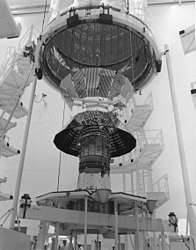 |
1974-097A | ||
| Helios B | January 1976 – 1985? | orbiter | success | 1976-003A | ||||
| ISEE-3 | 1978–1982 | orbiter | success | observed solar phenomena in conjunction with earth-orbiting ISEE-1 and ISEE-2; later renamed International Cometary Explorer (ICE) and directed to Comet Giacobini-Zinner | 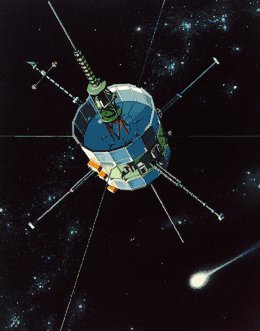 |
1976-003A | ||
| Ulysses (first pass) |
1994 | orbiter | success | south polar observations | 1990-090B | |||
| 1995 | north polar observations | |||||||
| WIND | November 1994 – still active as of February 2020[2] | orbiter | success | solar wind measurements |  |
1994-071A | ||
| SOHO | May 1996 – extended to December 2020[3] | orbiter | success | investigation of Sun's core, corona, and solar wind; comet discoveries | 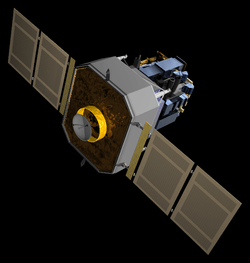 |
1995-065A | ||
| ACE | August 1997 – projected until 2024[4] | orbiter | success | solar wind observations | 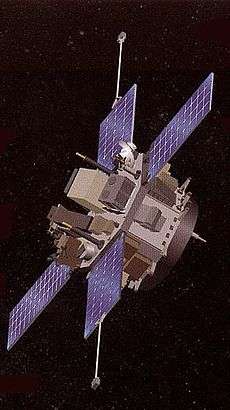 |
1997-045A | ||
2000–present
| Spacecraft | Organization | Date | Type | Status | Notes | Image | Ref | |
|---|---|---|---|---|---|---|---|---|
| Ulysses (second pass) |
2000 | orbiter | success | south polar observations | 1990-090B | |||
| 2001 | north polar observations | |||||||
| Genesis | 2001–2004 | orbiter/ sample return |
success | solar wind sample return; crash landed on return to Earth, much data salvaged | 2001-034A | |||
| STEREO A | December 2006 – still active as of September 2016[5][6] |
orbiter | success | stereoscopic imaging of coronal mass ejections and other solar phenomena | 2006-047A | |||
| STEREO B | December 2006 – October 2014. August 2016 – October 2018 (communication lost between 1 October 2014 and 21 August 2016) NASA directed that periodic recovery operations of Stereo-B cease with last support on October 17, 2018.[6][7] |
orbiter | success | 2006-047B | ||||
| Ulysses (third pass) |
2007 | orbiter | success | south polar observations | 1990-090B | |||
| 2008 | partial success | north polar observations; some data returned despite failing power and reduced transmission capacity | ||||||
| DSCOVR | February 2015 – | orbiter | success | solar wind and coronal mass ejection monitoring, as well as Earth climate monitoring | 2015-007A [8] | |||
| Parker Solar Probe | November 2018 – December 2025 | orbiter/flyby (approach 26 times) |
en route | close-range solar coronal study | 2018-065A [9] | |||
| Solar Orbiter | 10 February 2020 (launch) | orbiter | en route | solar and heliospheric physics | 2020-010A [10] | |||
Mercury probes
| Spacecraft | Organization | Date | Type | Status | Notes | Image | Ref | |
|---|---|---|---|---|---|---|---|---|
| Mariner 10 | 29 March 1974 | flyby | success | minimum distance 704 km | 1973-085A | |||
| 21 September 1974 | 48,069 km | |||||||
| 16 March 1975 | 327 km | |||||||
| MESSENGER | 14 January 2008 | flyby | success | minimum distance 200 km | 2004-030A | |||
| 6 October 2008 | minimum distance 200 km | |||||||
| 29 September 2009 | minimum distance 228 km | |||||||
| 18 March 2011 – 30 April 2015 |
orbiter | success | first spacecraft to orbit Mercury; unavoidable impact on the surface at end of mission | |||||
| BepiColombo | October 2021 | flyby | en route | BEPICLMBO | ||||
| June 2022 | en route | |||||||
| June 2023 | ||||||||
| September 2024 | ||||||||
| December 2024 | ||||||||
| January 2025 | ||||||||
| Mercury Planetary Orbiter |
5 December 2025 (orbital insertion) 14 March 2026 (final MPO orbit) |
orbiter | en route | |||||
| Mio (Mercury Magnetospheric Orbiter) |
5 December 2025 (orbital insertion) | orbiter | en route | |||||
Venus probes
1961–1969
| Spacecraft | Organization | Date | Type | Status | Notes | Image | Ref | |
|---|---|---|---|---|---|---|---|---|
| Tyazhely Sputnik | 4 February 1961 | lander | failure | failed to escape from Earth orbit | 1961-002A | |||
| Venera 1 | 19 May 1961 – 20 May 1961 |
flyby | failure | contact lost 7 days after launch; first spacecraft to fly by another planet | 1961-003A | |||
| Mariner 1 | 22 July 1962 | flyby | failure | guidance failure shortly after launch | MARIN1 | |||
| Sputnik 19 | 25 August 1962 | lander | failure | failed to escape Earth orbit | 1962-040A | |||
| Sputnik 20 | 1 September 1962 | lander | failure | failed to escape Earth orbit | 1962-043A | |||
| Sputnik 21 | 12 September 1962 | flyby | failure | third stage exploded | 1962-045A | |||
| Mariner 2 | 14 December 1962 | flyby | success | first successful Venus flyby; minimum distance 34,773 km | 1962-041A | |||
| Cosmos 21† | 11 November 1963 | flyby? | failure | failed to escape Earth orbit | 1963-044A | |||
| Venera 1964A† | 19 February 1964 | flyby | failure | failed to reach Earth orbit | [1] | |||
| Venera 1964B† | 1 March 1964 | flyby | failure | failed to reach Earth orbit | [1] | |||
| Cosmos 27 | 27 March 1964 | flyby | failure | failed to escape Earth orbit | 1964-014A | |||
| Zond 1 | 1964 | flyby and possible lander | failure | contact lost en route | 1964-016D | |||
| Cosmos 96 | 23 November 1965 | lander | failure | exploded? | 1965-094A | |||
| Venera 1965A† | 26 November 1965 | flyby | failure | launch vehicle failure? | [1] | |||
| Venera 2 | 27 February 1966 | flyby | failure | ceased to operate en route | 1965-091A | |||
| Venera 3 | 1 March 1966 | lander | failure | contact lost before arrival; first spacecraft to impact on the surface of another planet | 1965-092A | |||
| Kosmos 167 | 17 June 1967 | lander | failure | failed to escape Earth orbit | 1967-063A | |||
| Venera 4 | 18 October 1967 | atmospheric probe | success | continued to transmit to an altitude of 25 km | 1967-058A | |||
| Mariner 5 | 19 October 1967 | flyby | success | minimum distance 5,000 km | 1967-060A | |||
| Venera 5 | 16 May 1969 | atmospheric probe | success | transmitted atmospheric data for 53 minutes, to an altitude of about 26 km | 1969-001A | |||
| Venera 6 | 17 May 1969 | atmospheric probe | success | transmitted atmospheric data for 51 minutes, to an altitude of perhaps 10–12 km | 1969-002A | |||
1970–1978
| Spacecraft | Organization | Date | Type | Status | Notes | Image | Ref | |
|---|---|---|---|---|---|---|---|---|
| Cosmos 359 | 22 August 1970 | lander? | failure | failed to escape Earth orbit | 1970-065A | |||
| Venera 7 | 15 December 1970 | lander | success | first successful landing on another planet; signals returned from surface for 23 minutes | 1970-060A | |||
| Cosmos 482 | 31 March 1972 | lander? | failure | failed to escape Earth orbit | 1972-023A | |||
| Venera 8 | 22 July 1972 | lander | success | signals returned from surface for 50 minutes | 1972-021A | |||
| Mariner 10 | 5 February 1974 | flyby | success | minimum distance 5768 km, en route to Mercury; first use of gravity assist by an interplanetary spacecraft | 1973-085A | |||
| Venera 9 | 1975 | orbiter | success | first spacecraft to orbit Venus; communications relay for lander; atmospheric and magnetic studies | 1975-050A | |||
| 22 October 1975 | lander | success | first images from the surface; operated on surface for 53 minutes | 1975-050D | ||||
| Venera 10 | 1975 | orbiter | success | communications relay for lander; atmospheric and magnetic studies | 1975-054A | |||
| 23 October 1975 | lander | success | transmitted from surface for 65 minutes | 1975-054D | ||||
| Pioneer Venus Orbiter | 4 December 1978 – 1992 |
orbiter | success | atmospheric and magnetic studies | 1978-051A | |||
| Pioneer Venus Multiprobe | 9 December 1978 | 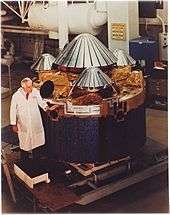 |
||||||
| bus | probe transporter | success | deployed four atmospheric probes, then burnt up in Venusian atmosphere, continuing to transmit to 110 km altitude | 1978-078A | ||||
| large probe | atmospheric probe | success | 1978-078D | |||||
| north probe | atmospheric probe | success | 1978-078E | |||||
| day probe | atmospheric probe | success | survived impact and continued to transmit from surface for over an hour | 1978-078G | ||||
| night probe | atmospheric probe | success | 1978-078F | |||||
| Venera 12 | ||||||||
| flight platform | 21 December 1978 | flyby | success | minimum distance 34,000 km; deployed lander and then acted as communications relay | 1978-086A | |||
| descent craft | 21 December 1978 | lander | partial success | soft landing; transmissions returned for 110 minutes; failure of some instruments | 1978-086C | |||
| Venera 11 | identical to Venera 12 | |||||||
| flight platform | 25 December 1978 | flyby | success | minimum distance 34,000 km; deployed lander and then acted as communications relay | 1978-084A | |||
| descent craft | 25 December 1978 | lander | partial success | soft landing; transmissions returned for 95 minutes; failure of some instruments | 1978-084D | |||
1982–1999
| Spacecraft | Organization | Date | Type | Status | Notes | Image | Ref | |
|---|---|---|---|---|---|---|---|---|
| Venera 13 | ||||||||
| bus | 1 March 1982 | flyby | success | deployed lander and then acted as communications relay | 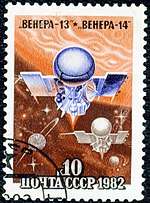 |
1981-106A | ||
| descent craft | 1 March 1982 | lander | success | survived on surface for 127 minutes | 1981-106D | |||
| Venera 14 | identical to Venera 13 | |||||||
| bus | 5 March 1982 | flyby | success | deployed lander and then acted as communications relay |  |
1981-110A | ||
| descent craft | 5 March 1982 | lander | success | survived on surface for 57 minutes | 1981-110D | |||
| Venera 15 | 1983–1984 | orbiter | success | radar mapping | 1983-053A | |||
| Venera 16 | 1983–1984 | orbiter | success | radar mapping; identical to Venera 15 | 1983-054A | |||
| Vega 1 | 11 June 1985 | flyby | success | went on to fly by Halley's comet | 1984-125A | |||
| lander | failure | instruments deployed prematurely | 1984-125E | |||||
| atmospheric balloon | success | floated at an altitude of about 54 km and transmitted for around 46 hours | 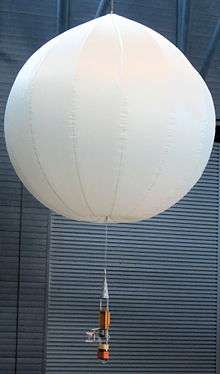 |
1984-125F | ||||
| Vega 2 | 15 June 1985 | flyby | success | went on to fly by Halley's comet | 1984-128A | |||
| lander | success | transmitted from surface for 56 minutes | 1984-128E | |||||
| atmospheric balloon | success | floated at an altitude of about 54 km and transmitted for around 46 hours |  |
1984-128F | ||||
| Galileo | 10 February 1990 | flyby | success | gravity assist en route to Jupiter; minimum distance 16,000 km |  |
[13] | ||
| Magellan | 10 August 1990 – 12 October 1994 |
orbiter | success | global radar mapping | 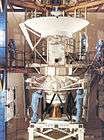 |
1989-033B [14] | ||
| Cassini | 26 April 1998 | flyby | success | gravity assist en route to Saturn |  |
1997-061A [15] | ||
| 24 June 1999 | ||||||||
2006–present
| Spacecraft | Organization | Date | Type | Status | Notes | Image | Ref | |
|---|---|---|---|---|---|---|---|---|
| Venus Express | 11 April 2006 – 18 January 2015 | orbiter | success | atmospheric studies; planetary imaging; magnetic observations | 2005-045A | |||
| MESSENGER | 24 October 2006 | flyby | success | gravity assist only; minimum distance 2990 km | 2004-030A | |||
| 6 June 2007 | success | minimum distance 300 km; en route to Mercury | ||||||
| Akatsuki (PLANET-C) |
6 December 2010 (Venus flyby) | orbiter | failure | failed orbital insertion in 2010; success in 2015 science mission ongoing since May 2016 |
2010-020D | |||
| 7 December 2015 (orbital insertion) – | orbiter | success | ||||||
| IKAROS | 8 December 2010 | flyby[16] | success | solar sail technology development / interplanetary space exploration | 2010-020E [17] | |||
| Shin'en (UNITEC-1) |
December 2010? | flyby[18] | failure | contact lost shortly after launch | 2010-020F [19][20] | |||
| Parker Solar Probe | October 2018 – November 2024 | flyby (approach 7 times) | en route | gravity assist en route to solar corona | 2018-065A [9] | |||
| BepiColombo (first pass) |
October 2020 | flyby | en route | gravity assist en route to Mercury, during which it will study Venus' atmosphere and solar environment | BEPICLMBO | |||
| Solar Orbiter | 2020 | flyby | en route | gravity assist en route to inclined heliocentric orbit for solar polar observations | [10] | |||
| BepiColombo (second pass) |
August 2021 | flyby | en route | gravity assist en route to Mercury | BEPICLMBO | |||
Proposed
| Spacecraft | Organization | Date | Type | Status | Notes | Image | Ref | |
|---|---|---|---|---|---|---|---|---|
| JUICE | 2023 | flyby | planned | gravity assist en route to Jupiter | [21] | |||
| Shukrayaan-1 | 2023 | orbiter + balloons | planned | [22][23][24] | ||||
| Venus In Situ Explorer | 2024 | lander or airplane | proposed | [25] | ||||
| Venera-D | 2025 | orbiter, lander | proposed | [26][27] | ||||
| Dragonfly | 2027 | flyby | planned | gravity assist en route to Titan | [28] | |||
Earth flybys
In addition, several planetary probes have sent back observations of the Earth-Moon system shortly after launch, most notably Mariner 10, Pioneers 10 and 11 and both Voyager probes (Voyager 1 and Voyager 2).
Lunar probes
Mars probes
1960–1969
| Spacecraft | Organization | Date | Type | Status | Notes | Image | Ref | |
|---|---|---|---|---|---|---|---|---|
| Mars 1M No.1 | 10 October 1960 | flyby | failure | failed to reach Earth orbit | MARSNK1 | |||
| Mars 1M No.2 | 14 October 1960 | flyby | failure | failed to reach Earth orbit | MARSNK2 | |||
| Mars 1962A | 24 October 1962 | flyby | failure | exploded in or en route to Earth orbit | 1962-057A | |||
| Mars 1962B | 11 November 1962 (launch) | lander | failure | broke up during transfer to Mars trajectory | 1962-062A | |||
| Mars 1 | 19 June 1963 | flyby | failure | contact lost en route; flew within approximately 193,000 km of Mars | 1962-061A | |||
| Mariner 3 | 5 November 1964 | flyby | failure | protective shield failed to eject, preventing craft from attaining correct trajectory | 1964-073A | |||
| Mariner 4 | 15 July 1965 | flyby | success | first close-up images of Mars | 1964-077A | |||
| Zond 2 | 6 August 1965 | flyby | failure | contact lost en route; flew within 1,500 km of Mars | 1964-078C | |||
| Mariner 6 | 31 July 1969 | flyby | success | 1969-014A | ||||
| Mariner 7 | 5 August 1969 | flyby | success | 1969-030A | ||||
| Mars 1969A | 27 March 1969 (launch) | orbiter | failure | launch failure | MARS69A | |||
| Mars 1969B | 2 April 1969 (launch) | orbiter | failure | launch failure | MARS69B | |||
1971–1976
| Spacecraft | Organization | Date | Type | Status | Notes | Image | Ref | |
|---|---|---|---|---|---|---|---|---|
| Mariner 8 | 9 May 1971 (launch) | orbiter | failure | launch vehicle failure | MARINH | |||
| Kosmos 419 | 10 May 1971 (launch) | orbiter | failure | failed to escape Earth orbit | 1971-042A | |||
| Mariner 9 | 14 November 1971 – 27 October 1972 |
orbiter | success | first spacecraft to orbit another planet | 1971-051A | |||
| Mars 2 | 27 November 1971 – 22 August 1972 |
orbiter | success | first Russian spacecraft to orbit another planet | 1971-045A | |||
| Mars 2 Lander | 27 November 1971 | lander and short range rover | failure | crashed; first manmade object to reach surface of Mars | 1971-045D | |||
| Mars 3 | 2 December 1971 – 22 August 1972 |
orbiter | partial success | attained a different orbit than intended due to insufficient fuel | 1971-049A | |||
| Mars 3 Lander | 2 December 1971 | lander and short range rover | partial success | first soft landing on Mars; contact lost 110 sec after soft landing, first picture from surface | 1971-049F | |||
| Mars 4 | 10 February 1974 | orbiter | failure | orbit insertion failed, became flyby | 1973-047A | |||
| Mars 5 | 12 February 1974 – 28 February 1974 |
orbiter | success | 1973-049A | ||||
| Mars 6 | 12 March 1974 | flyby | success | 1973-052A | ||||
| Mars 6 Lander | 12 March 1974 | lander | failure | contact lost 148 sec after parachute deployment (returned 224 seconds of atmospheric data) | ||||
| Mars 7 | 9 March 1974 | flyby | success | 1973-053A | ||||
| Mars 7 Lander | 9 March 1974 | lander | failure | missed Mars | ||||
| Viking 1 Orbiter | 19 June 1976 – 17 August 1980 |
orbiter | success | 1975-075A | ||||
| Viking 1 Lander | 20 July 1976 – 13 November 1982 |
lander | success | 1975-075C | ||||
| Viking 2 Orbiter | 7 August 1976 – 25 July 1978 |
orbiter | success | 1975-083A | ||||
| Viking 2 Lander | 3 September 1976 – 11 April 1980 |
lander | success | 1975-083C | ||||
1988–1999
| Spacecraft | Organization | Date | Type | Status | Notes | Image | Ref | |
|---|---|---|---|---|---|---|---|---|
| Phobos 1 | 7 July 1988 (launch) | orbiter | failure | contact lost en route to Mars | 1988-058A | |||
| Phobos 2 | 29 January 1989 – 27 March 1989 |
orbiter | partial success | Mars orbit acquired, but contact lost shortly before Phobos approach phase and deployment of Phobos landers | 1988-059A | |||
| Mars Observer | 25 September 1992 (launch) | orbiter | failure | contact lost shortly before Mars orbit insertion | 1992-063A | |||
| Mars 96 | 16 November 1996 (launch) | orbiter | failure | failed to escape Earth orbit | 1996-064A | |||
| lander | MARS96B | |||||||
| lander | MARS96C | |||||||
| penetrator | 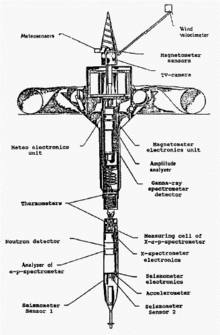 |
MARS96D | ||||||
| penetrator | MARS96E | |||||||
| Mars Pathfinder | 4 July 1997 – 27 September 1997 |
lander | success | 1996-068A | ||||
| Sojourner | 6 July 1997 – 27 September 1997 |
rover | success | first Mars rover | MESURPR | |||
| Mars Global Surveyor | 12 September 1997 – 2 November 2006 |
orbiter | success | 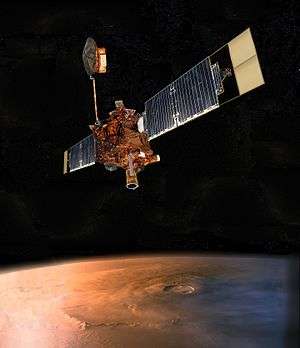 |
1996-062A | |||
| Mars Climate Orbiter | 23 September 1999 | orbiter | failure | Mars orbit insertion failed due to navigation error |  |
1998-073A | ||
| Mars Polar Lander | 3 December 1999 | lander | failure | contact lost just prior to entering Martian atmosphere | 1999-001A | |||
| Deep Space 2 "Amundsen" | 3 December 1999 | penetrator | DEEPSP2 | |||||
| Deep Space 2 "Scott" | 3 December 1999 | penetrator | ||||||
2001–2009
| Spacecraft | Organization | Date | Type | Status | Notes | Image | Ref | |
|---|---|---|---|---|---|---|---|---|
| 2001 Mars Odyssey | 24 October 2001 – | orbiter | success | studying climate and geology; communications relay for Spirit and Opportunity rovers longest surviving spacecraft in orbit around a planet other than Earth |
2001-014A | |||
| Nozomi | 14 December 2003 | orbiter | failure | failed to attain Mars orbit, became flyby | 1998-041A | |||
| Mars Express | 25 December 2003 – | orbiter | success | surface imaging and mapping; first European probe in Martian orbit | 2003-022A | |||
| Beagle 2 | 25 December 2003 | lander | failure | Deployed by the Mars Express; lost for 11 years and imaged by NASA's MRO in 2015[29] | 2003-022C | |||
| MER-A "Spirit" | 4 January 2004 – 22 March 2010 | rover | success | became stuck in May 2009; then operating as a static science station until contact lost in March 2010 | 2003-027A | |||
| MER-B "Opportunity" | 25 January 2004 – 10 June 2018 | rover | success | lost contact 10 June 2018 due to 2018 global dust storm. NASA concluded mission on 13 February 2019 after failed communication attempts since August 2018. | 2003-032A | |||
| Mars Reconnaissance Orbiter | 10 March 2006 – | orbiter | success | surface imaging and surveying | 2005-029A | |||
| Rosetta | 25 February 2007 | flyby | success | gravity assist en route to asteroid and comet encounters | 2004-006A | |||
| Phoenix | 25 May 2008 – 10 November 2008 |
lander | success | collection of soil samples near the northern pole to search for water and investigate Mars' geological history and biological potential | 2007-034A [30] | |||
| Dawn | 17 February 2009 | flyby | success | gravity assist en route to Vesta and Ceres | 2007-043A | |||
2011–2018
| Spacecraft | Organization | Date | Type | Status | Notes | Image | Ref | |
|---|---|---|---|---|---|---|---|---|
| Fobos-Grunt | 8 November 2011 (launch) | orbiter and Phobos sample return | failure | failed to escape Earth orbit | 2011-065A | |||
| Yinghuo-1 | orbiter | YINGHUO-1 | ||||||
| MSL Curiosity | 6 August 2012 – | rover | success | investigation of past and present habitability, climate and geology | 2011-070A [31] | |||
| Mangalyaan / Mars Orbiter Mission | 24 September 2014 – | orbiter | success | technology development; studying Martian atmosphere; mineralogical mapping. | 2013-060A [32][33] | |||
| MAVEN | 25 September 2014 – | orbiter | success | studying Martian atmosphere | 2013-063A [34] | |||
| ExoMars Trace Gas Orbiter (ExoMars 2016) | 19 October 2016 – | orbiter | in orbit | atmospheric gas analysis; communication relay for surface probes | 2016-017A [35] | |||
| Schiaparelli EDM lander | 19 October 2016 | lander | crashed upon landing[36] | landing test, meteorological observation | ||||
| InSight | 26 November 2018 – | lander | landed | full deployment will take 3 months after landing[37] |  |
INSIGHT [38] | ||
| MarCO A "WALL-E" | 26 November 2018 | flyby | success | relaying data from InSight during its entry, descent, and landing | ||||
| MarCO B "EVE" | 26 November 2018 | flyby | success | |||||
2020–Present
| Spacecraft | Organization | Date | Type | Status | Notes | Image | Ref | |
|---|---|---|---|---|---|---|---|---|
| Emirates Mars Mission | 19 July 2020 (launch) | orbiter | en route | conduct studies of Martian atmosphere | EMM-HOPE [39] | |||
| Tianwen-1 orbiter | 23 July 2020 (launch) | orbiter | en route | orbital studies of Martian surface morphology, soil, and atmosphere | HUOXING+1 [40][41][42] | |||
| Tianwen-1 lander/rover | 23 July 2020 (launch) | lander/rover | en route | in-situ studies of Martian surface morphology, soil, and atmosphere | ||||
| Mars 2020 Perseverance | 30 July2020 (launch) | rover | en route | investigate past and present habitability, climate, and geology; produce O2 from CO2; collect samples for Mars Sample Return Mission | 2020-052A [43] | |||
| Mars Helicopter Ingenuity | 30 July 2020 (launch) | robotic helicopter | en route | providing guidance for the Perseverance rover | ||||
Proposed
| Spacecraft | Organization | Date | Type | Status | Notes | Image | Ref | |
|---|---|---|---|---|---|---|---|---|
| ExoMars Kazachok (ExoMars 2022) | 2022 | lander | planned | [44][45] | ||||
| Rosalind Franklin | 2022 | rover | planned | |||||
| Psyche | 2022 (launch) 2023 (flyby) |
flyby | planned | gravity assist en route to Psyche | [46] | |||
| JUICE | 2022 (launch) February 2025 (flyby) |
flyby | planned | gravity assist en route to Jupiter | [21] | |||
| ZhengHe | 2022 (launch) 2025 (flyby) |
flyby | planned | gravity assist en route to 133P/Elst-Pizzaro | [47] | |||
| Martian Moons Exploration (MMX) | 2024 (launch) Mid-2025 (arrival) |
orbiter | planned | monitoring Martian climate | [48] | |||
| Mars Sample Return Mission | 2026 | orbiter, lander, rover, and sample return | under study | [49][50] | ||||
| Next Mars Orbiter (NeMO) | Late 2020s[51] | orbiter | under study | Laser communications relay, high-resolution mapping | [52] | |||
| Mars Orbiter Mission 2 | TBD | orbiter, possible lander and rover |
planned | Mission architecture not finalized |
[53][54][53] | |||
Phobos probes
| Spacecraft | Organization | Date | Type | Status | Notes | Image | Ref | |
|---|---|---|---|---|---|---|---|---|
| Phobos 1 | 7 July 1988 (launch) | flyby | failure | contact lost en route to Mars | 1988-058A | |||
| DAS | 2 September 1988 | fixed lander | failure | never deployed | ||||
| Phobos 2 | 27 March 1989 (contact lost) | flyby | failure | attained Mars orbit; contact lost prior to deployment of lander | 1988-059A | |||
| DAS | 27 March 1989 | fixed lander | failure | never deployed | ||||
| "Frog" | 27 March 1989 | mobile lander | failure | never deployed | ||||
| Fobos-Grunt | 8 November 2011 (launch) | sample return | failure | failed to escape Earth orbit; launched with Yinghuo-1 Mars orbiter | 2011-065A | |||
| MMX | 2024 (launch) 2025 (arrival) |
sample return | planned | orbital insertion in 2025 | [55][56] | |||
| MMX rover | 2025 | rover | planned | |||||
Ceres probes
| Spacecraft | Organization | Date | Type | Status | Notes | Image | Ref | |
|---|---|---|---|---|---|---|---|---|
| Dawn | 6 March 2015 – 1 November 2018 | orbiter | success | first spacecraft to orbit two different celestial bodies; previously visited Vesta | 2007-043A | |||
Asteroid probes
| Target | Spacecraft | Organization | Date | Type | Status | Notes | Image | Ref | |
|---|---|---|---|---|---|---|---|---|---|
| 951 Gaspra | Galileo | 29 October 1991 | flyby | success | en route to Jupiter; minimum distance 1900 km |  |
[13] | ||
| 243 Ida | Galileo | 28 August 1993 | flyby | success | en route to Jupiter; minimum distance 2400 km; discovery of the first asteroid satellite Dactyl |  |
[13] | ||
| 1620 Geographos | Clementine | 1994 | flyby | failure | flyby cancelled due to equipment malfunction | 1994-004A | |||
| 253 Mathilde | NEAR Shoemaker |
27 June 1997 | flyby | success | flew within 1200 km of 253 Mathilde en route to 433 Eros |  |
1996-008A | ||
| 433 Eros | NEAR Shoemaker |
January 1999 | orbiter | failure | became flyby due to software and communications problems (later attempt at orbit insertion succeeded; see below) |  |
1996-008A | ||
| 9969 Braille | Deep Space 1 | 29 July 1999 | flyby | partial success | no close-up images due to camera pointing error; went on to visit comet 19P/Borrelly | 1998-061A | |||
| 2685 Masursky | Cassini | 23 January 2000 | distant flyby | success | en route to Saturn |  |
1997-061A | ||
| 433 Eros | NEAR Shoemaker |
February 2000 – February 2001 |
orbiter, became lander | success | improvised landing by orbiter at end of mission |  |
1996-008A | ||
| 5535 Annefrank | Stardust | 2 November 2002 | distant flyby | success | went on to visit comet 81P/Wild | 1999-003A | |||
| 25143 Itokawa | Hayabusa | 2005–07 | sample return | success | 2005: landed and collected dust grains. 2010: sample returned. |
2003-019A | |||
| MINERVA | 12 November 2005 | hopper | failure | missed target | |||||
| 132524 APL | New Horizons | June 2006 | distant flyby | success | flew past Pluto successfully | 2006-001A | |||
| 2867 Šteins | Rosetta | 5 September 2008 | flyby | success | en route to comet 67P/Churyumov–Gerasimenko | 2004-006A | |||
| 21 Lutetia | Rosetta | 11 July 2010 | flyby | success | en route to comet 67P/Churyumov–Gerasimenko | 2004-006A | |||
| 4 Vesta | Dawn | 16 July 2011 – 5 September 2012 | orbiter | success | first spacecraft to orbit two different celestial bodies; now orbiting Ceres | 2007-043A | |||
| 4179 Toutatis | Chang'e 2 | 13 December 2012 | flyby | success | 2010-050A | ||||
| 2000 DP107 | PROCYON | 12 May 2016[57] | flyby | failure | launched with Hayabusa2 in 2014; mission abandoned after ion thruster failure[58] | 2014-076D | |||
| 162173 Ryugu | Hayabusa2 | 27 June 2018 – 13 November 2019 | sample return | en route | orbital insertion in June 2018, sample capture in 2019, return to Earth in 2020 | 2014-076A | |||
| Minerva II-1A | 21 September 2018 | hopper | success | ||||||
| Minerva II-1B | 21 September 2018 | hopper | success | ||||||
| MASCOT | 3 October 2018 | mobile lander | success | ||||||
| Minerva II-2 | 2 October 2019 | hopper | failure | Rover failed before deployment, it was deployed in orbit around the asteroid to perform gravitational measurements before it impacted on 8 October 2019. | |||||
| SCI | 2019 | impactor | success | ||||||
| DCAM-3 | 2019 | orbiter | success | observing SCI's impact, and the ejecta created by the impact | |||||
| 101955 Bennu | OSIRIS-REx | August 2018 | sample return | in orbit | orbital insertion in 2018, sample capture in 2020, return to Earth in 2023 |  |
2016-055A | ||
| 2002 GT | Deep Impact | January 2020[59] | flyby | failure | contact lost; previously visited comet 103P/Hartley | 2005-001A | |||
| ? | Near-Earth Asteroid Scout | 2021 (launch) | flyby | planned | Small spacecraft asteroid flyby technology demonstration | [60] | |||
| 65803 Didymos | DART | 2021 (launch) October 2022 (flyby) |
flyby | planned | [61] | ||||
| LICIA | 2022 | flyby | planned | observe DART's impact | |||||
| (65803) Dimorphos | DART | October 2022 (impact) | impactor | planned | [62] | ||||
| 52246 Donaldjohanson | Lucy | 2021 (launch) April 2025 (flyby) |
flyby | planned | Selected for mission #13 of NASA's Discovery Program, main-belt asteroid flyby en route to Jupiter Trojans | [46] | |||
| 469219 Kamo‘oalewa | ZhengHe | 2022 (launch) 2023 (orbit) |
sample return | planned | orbit then return sample from an Apollo NEA | [42][47] | |||
| 16 Psyche | Psyche | 2022 (launch) 2026 (arrival) |
orbiter | planned | Selected for mission #14 of NASA's Discovery Program | [46] | |||
| 3200 Phaethon | DESTINY+ | 2022 (launch) 2026 (arrival) |
flyby | planned | First flyby of a rock comet | [63] | |||
| 3548 Eurybates | Lucy | August 2027 | flyby | planned | First flyby of a Jupiter trojan | [46] | |||
| 15094 Polymele | Lucy | September 2027 | flyby | planned | [46] | ||||
| 65803 Didymos | Hera | 2027 | orbiter | planned | studying effects of DART's impact on the asteroid | [64][65] | |||
| APEX | 2027 | orbiter | planned | to be deployed from Hera | |||||
| Juventas | 2027 | orbiter | planned | to be deployed from Hera | |||||
| (65803) Dimorphos | APEX | lander | planned | [65] | |||||
| Juventas | lander | planned | |||||||
| 11351 Leucus | Lucy | April 2028 | flyby | planned | [46] | ||||
| 21900 Orus | Lucy | November 2028 | flyby | planned | [46] | ||||
| 7968 Elst-Pizarro | ZhengHe | 2022 (launch) 2030 (orbit) |
orbiter | planned | study of an asteroid/main-belt comet | [42][47] | |||
| Patroclus and Menoetius | Lucy | March 2033 | flyby | planned | First flyby of a Trojan Camp Jupiter Trojan | [46] | |||
Jupiter probes
| Spacecraft | Organization | Date | Type | Status | Notes | Image | Ref | |
|---|---|---|---|---|---|---|---|---|
| Pioneer 10 | 3 December 1973 | flyby | success | first probe to cross the asteroid belt; first Jupiter probe; first man-made object on an interstellar trajectory; now in the outer regions of the Solar System but no longer contactable | 1972-012A | |||
| Pioneer 11 | 4 December 1974 | flyby | success | went on to visit Saturn | 1973-019A | |||
| Voyager 1 | 5 March 1979 | flyby | success | went on to visit Saturn | 1977-084A | |||
| Voyager 2 | 9 July 1979 | flyby | success | went on to visit Saturn, Uranus and Neptune | 1977-076A | |||
| Ulysses (first pass) |
February 1992 | flyby | success | gravity assist en route to inclined heliocentric orbit for solar polar observations | 1990-090B | |||
| Galileo Orbiter | 7 December 1995 – 21 September 2003 |
orbiter | success | also flew by various of Jupiter's moons; intentionally flown into Jupiter at end of mission; first spacecraft to orbit Jupiter; first spacecraft to flyby an asteroid |  |
1989-084B | ||
| Galileo Probe | 7 December 1995 | atmospheric probe | success | first probe to enter Jupiter's atmosphere |  |
1989-084E | ||
| Cassini | December 2000 | flyby | success | gravity assist en route to Saturn |  |
1997-061A | ||
| Ulysses (second pass) |
2003–04 | distant flyby | success | 1990-090B | ||||
| New Horizons | 28 February 2007 | flyby | success | gravity assist en route to Pluto | 2006-001A | |||
| Juno | 5 July 2016 – July 2018, with spacecraft disposal planned for July 2021[66] | orbiter | success | First solar-powered Jupiter orbiter, first mission to achieve a polar orbit of Jupiter. | 2011-040A | |||
| JUICE | 2022 (launch) | orbiter | planned | mission to study Jupiter's three icy moons Callisto, Europa and Ganymede, eventually orbiting Ganymede as the first spacecraft to orbit a satellite of another planet | [67] | |||
| Europa Clipper | 2020s | orbiter | under study | planned to orbit Jupiter and fly by Europa multiple times | [68] | |||
| IHP-1 | 2024 (launch,) 2029 (Jupiter closest approach) | flyby | under study | Proposed Interstellar Heliosphere Probe with Jovian gravity assist | [69] | |||
| IHP-2 | 2024 (launch,) 2033 (Jupiter closest approach) | flyby | under study | Proposed Interstellar Heliosphere Probe with Jovian gravity assist (and later Neptune and KBO flybys) | [69] | |||
| Chinese Jupiter orbiter | 2029 or early 2030s | orbiter | under study | Proposed Jupiter orbiter with possible attached Uranus probe | [70][71][72] | |||
Saturn probes
| Spacecraft | Organization | Date | Type | Status | Notes | Image | Ref | |
|---|---|---|---|---|---|---|---|---|
| Pioneer 11 | 1 September 1979 | flyby | success | previously visited Jupiter | 1973-019A | |||
| Voyager 1 | 12 November 1980 | flyby | success | previously visited Jupiter | 1977-084A | |||
| Voyager 2 | 5 August 1981 | flyby | success | previously visited Jupiter, went on to visit Uranus and Neptune | 1977-076A | |||
| Cassini | 1 July 2004 – 15 September 2017 | orbiter | success | also performed flybys of a number of Saturn's moons, and deployed the Huygens Titan lander; first spacecraft to orbit Saturn |  |
1997-061A | ||
Titan probes
| Spacecraft | Organization | Date | Type | Status | Notes | Image | Ref | |
|---|---|---|---|---|---|---|---|---|
| Huygens | 14 January 2005 | atmospheric probe, lander | success | deployed by Cassini; first probe to land on a satellite of another planet | 1997-061C | |||
| Dragonfly | 2025 | rotorcraft lander | planned | planned lander and aircraft, study prebiotic chemistry and extraterrestrial habitability. |  |
[73][74] | ||
Uranus probes
| Spacecraft | Organization | Date | Type | Status | Notes | Image | Ref | |
|---|---|---|---|---|---|---|---|---|
| Voyager 2 | 24 January 1986 | flyby | success | previously visited Jupiter and Saturn; went on to visit Neptune | 1977-076A | |||
Neptune probes
| Spacecraft | Organization | Date | Type | Status | Notes | Image | Ref | |
|---|---|---|---|---|---|---|---|---|
| Voyager 2 | 25 August 1989 | flyby | success | previously visited Jupiter, Saturn and Uranus | 1977-076A | |||
| IHP-2 | 2024 (launch,) 2038 (Neptune closest approach) | flyby | under study | Proposed Interstellar Heliosphere Probe with Neptunian flyby and possible atmospheric impactor | [69] | |||
Pluto probes
| Spacecraft | Organization | Date | Type | Status | Notes | Image | Ref | |
|---|---|---|---|---|---|---|---|---|
| New Horizons | 14 July 2015 | flyby | success | later flew by Kuiper belt object 486958 Arrokoth when it was 43.4 AU from the Sun. | 2006-001A | |||
Comet probes
| Target | Spacecraft | Organization | Date | Type | Status | Notes | Image | Ref | |
|---|---|---|---|---|---|---|---|---|---|
| 21P/Giacobini-Zinner | ICE (formerly ISEE3) | 11 September 1985 | flyby | success | previously solar monitor ISEE3; went on to observe Halley's Comet |  |
1978-079A | ||
| 1P/Halley | Vega 1 | 6 March 1986 | flyby | success | minimum distance 8,890 km; previously visited Venus | 1984-125A | |||
| 1P/Halley | Suisei | 8 March 1986 | flyby | success | 151,000 km | 1985-073A | |||
| 1P/Halley | Vega 2 | 9 March 1986 | flyby | success | minimum distance 8,890 km; previously visited Venus | 1984-128A | |||
| 1P/Halley | Sakigake | March 1986 | distant flyby | partial success | minimum distance 6.99 million km | 1985-001A | |||
| 1P/Halley | Giotto | 14 March 1986 | flyby | success | minimum distance 596 km; went on to visit comet 26P/Grigg-Skjellerup | 1985-056A | |||
| 1P/Halley | ICE (formerly ISEE3) | 28 March 1986 | distant obser- vations |
success | minimum distance 32 million km; previously visited comet 21P/Giacobini-Zinner |  |
1978-079A | ||
| 26P/Grigg-Skjellerup | Giotto | 10 July 1992 | flyby | success | previously visited Halley's Comet | 1985-056A | |||
| 45P/ Honda-Mrkos-Pajdusakova |
Sakigake | 1996 | flyby | failure | contact lost; previously visited Halley's Comet | 1985-001A | |||
| 21P/Giacobini-Zinner | Sakigake | 1998 | flyby | failure | |||||
| 55P/Tempel-Tuttle | Suisei | 1998 | flyby | failure | abandoned due to lack of fuel; previously visited Halley's Comet | 1985-073A | |||
| 21P/Giacobini-Zinner | Suisei | 1998 | flyby | failure | |||||
| 19P/Borrelly | Deep Space 1 | 22 September 2001 | flyby | success | previously visited asteroid 9969 Braille | 1998-061A | |||
| 2P/Encke | CONTOUR | 2003 | flyby | failure | contact lost shortly after launch | 2002-034A | |||
| 81P/Wild | Stardust | 2 January 2004 | flyby, sample return | success | sample returned January 2006; also visited asteroid 5535 Annefrank | 1999-003A | |||
| 9P/Tempel | Deep Impact | July 2005 | flyby | success | 2005-001A | ||||
| Impactor | 4 July 2005 | impactor | success | ||||||
| 73P/ Schwassmann-Wachmann |
CONTOUR | 2006 | flyby | failure | contact lost shortly after launch | 2002-034A | |||
| 6P/d'Arrest | CONTOUR | 2008 | flyby | failure | contact lost shortly after launch | 2002-034A | |||
| 103P/Hartley | Deep Impact (redesignated EPOXI) | 4 November 2010 | flyby | success | mission extension (target changed from comet Boethin) | 2005-001A | |||
| 9P/Tempel | Stardust (redesignated NExT) | 14 February 2011 | flyby | success | mission extension | 1999-003A | |||
| 67P/Churyumov– Gerasimenko |
Rosetta | 6 August 2014 – 30 September 2016 | orbiter | success | flybys of asteroids 2867 Šteins and 21 Lutetia completed; intentionally impacted at end of mission | 2004-006A | |||
| Philae | 12 November 2014 – 9 July 2015 | lander | success | 2004-006C | |||||
| TBD (potentially an interstellar object) |
Comet Interceptor | 2028 (launch) | flyby | planned | flyby of a pristine comet, will initially be parked at the Sun-Earth L2 point until a suitable destination is identified | [75] | |||
| 133P/Elst-Pizarro | ZhengHe | 2022 (launch) 2030 (orbit) |
orbiter, lander | planned | study of an asteroid/main-belt comet | [42][47] | |||
Kuiper Belt probes
| Target | Spacecraft | Organization | Date | Type | Status | Notes | Image | Ref | |
|---|---|---|---|---|---|---|---|---|---|
| 486958 Arrokoth | New Horizons | 1 January 2019 | flyby | success | extended mission after Pluto, currently sending data from flyby; may flyby another object in 2020s.[76] | 2006-001A | |||
| To Be Determined | IHP-2 | 2024 (launch,) after 2038 (KBO flyby) | flyby | under study | Proposed Interstellar Heliosphere Probe with potential KBO target | [69] | |||
Probes leaving the Solar System
| Spacecraft | Organization | Notes | Image | Ref |
|---|---|---|---|---|
| Pioneer 10 | Left Jupiter in December 1973. Mission ended March 1997. Last contact 23 January 2003. Craft now presumed dead; no further contact attempts planned. | 1972-012A | ||
| Pioneer 11 | Left Saturn in September 1979. Last contact September 1995. The craft's antenna cannot be maneuvered to point to Earth, and it is not known if it is still transmitting. No further contact attempts are planned. | 1973-019A | ||
| Voyager 1 | Left Saturn in November 1980. Still in regular contact and transmitting scientific data. | 1977-084A | ||
| Voyager 2 | Left Neptune in August 1989. Still in regular contact and transmitting scientific data. | 1977-076A | ||
| New Horizons | Left Pluto 14 July 2015; flew by Kuiper belt object 486958 Arrokoth on 1 January 2019 when it was 43.4 AU from the Sun. | 2006-001A | ||
| IHP-1 | Proposed Interstellar Heliosphere Probe with a 2024 launch date. Anticipated to reach a distance of at least 85 AU from Earth by 2049 | [69] | ||
| IHP-2 | Proposed Interstellar Heliosphere Probe with a 2024 launch date. Anticipated to reach a distance of at least 83 AU from Earth by 2049 | [69] |
Other probes to leave Earth orbit
For completeness, this section lists probes that have left (or will leave) Earth orbit, but are not primarily targeted at any of the above bodies.
| Spacecraft | Organization | Date | Location | Status | Notes | Image | Ref | |
|---|---|---|---|---|---|---|---|---|
| WMAP | 30 June 2001 (launch) – October 2010 (end)[77] |
Sun-Earth L2 point | success | cosmic background radiation observations; sent to graveyard orbit after 9 years of use.[77] | 2001-027A | |||
| Spitzer Space Telescope | 25 August 2003 (launch) – 30 January 2020 (end) |
Earth-trailing heliocentric orbit | success | infrared astronomy | 2003-038A | |||
| Kepler | 6 March 2009 (launch) | Earth-trailing heliocentric orbit | completed (2009–2018) | search for extrasolar planets | 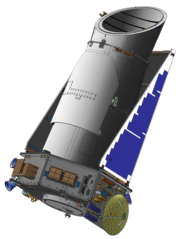 |
2009-011A [78] | ||
| Herschel Space Observatory | 14 May 2009 (launch) | Lissajous orbit around Sun-Earth L2 point | completed | study of formation and evolution of galaxies and stars | 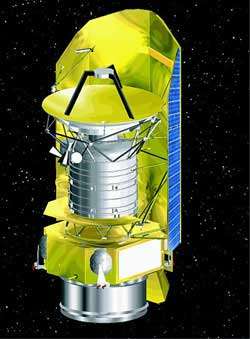 |
2009-026A | ||
| Planck | 14 May 2009 (launch) | Lissajous orbit around Sun-Earth L2 point | completed (2009–2013) | cosmic microwave background observations | 2009-026B | |||
| IKAROS | 20 May 2010 (launch) | Earth-Venus transfer heliocentric orbit | operational | solar sail technology development / interplanetary space exploration | 2010-020E [17] | |||
| Shin'en (UNITEC-1) |
failure | technology development; contact lost shortly after launch[20] | 2010-020F [19] | |||||
| Chang'e 2 | 25 August 2011 (arrive) – 15 April 2012 (end) |
Sun-Earth L2 point | success | Left the point on 15 April 2012, then flew by asteroid 4179 Toutatis | 2010-050A | |||
| Gaia | 19 December 2013 (launch) | Lissajous orbit around Sun-Earth L2 point | success | astrometry mission to measure the position and motion of 1 billion stars | 2013-074A [79] | |||
| Shin'en 2 | 3 December 2014 (launch) | heliocentric orbit | success | amateur radio satellite / material demonstration | 2014-076B[80] | |||
| ARTSAT2:DESPATCH | success | deep space artwork / amateur radio satellite | 2014-076C[81] | |||||
| LISA Pathfinder | 3 December 2015 (launch)[82] – 30 June 2017 (end) |
Halo orbit around Sun-Earth L1 point | success | test mission for proposed LISA gravitational wave observatory | 2015-070A [83] | |||
| Spektr-RG | 13 July 2019 (launch) | Halo orbit around Sun-Earth L2 point | operational | X-ray astronomy | 2019-040A[84] | |||
| James Webb Space Telescope | October 2021 (launch) | Sun-Earth L2 point | planned | infrared astronomy | [85] | |||
| Euclid | Q4, 2020 (launch)[86] | Halo orbit around Sun-Earth L2 point | planned | measure the rate of expansion of the Universe through time to better understand dark energy and dark matter | [87] | |||
Cancelled probes and missions
| Target | Spacecraft | Organization | Date | Type | Status | Notes | Image | Ref | |
|---|---|---|---|---|---|---|---|---|---|
| Mercury | BepiColombo Mercury Surface Element | lander | cancelled | ||||||
| Moon | LUNAR-A | orbiter, penetrators | cancelled | originally scheduled for 1995, cancelled 2007 | LUNAR-A | ||||
| Mars | Mars Surveyor 2001 Lander | 2001 | lander | cancelled | spacecraft bus repurposed for Phoenix lander | MS2001L | |||
| Mars | Beagle 2: Evolution | 2004 | lander | cancelled | |||||
| Mars | NetLander | lander | cancelled | [88] | |||||
| Mars | Mars Telecommunications Orbiter | 2010 | orbiter | cancelled | Mission could be fulfilled by the proposed Mars 2022 orbiter | [89] | |||
| Phobos, Deimos | Aladdin | sample return | not selected | [90] | |||||
| Europa | Europa Orbiter | orbiter | cancelled | [91] | |||||
| Europa, Ganymede, Callisto | Jupiter Icy Moons Orbiter | 2021 | orbiter | cancelled |  |
[92] | |||
| Pluto | Pluto Fast Flyby | 2010 | flyby | cancelled | Re-proposed as Pluto Kuiper Express | ||||
| Pluto | Pluto Kuiper Express |
2012 | flyby | cancelled | Replaced by New Horizons | PLUTOKE | |||
| 4660 Nereus | Hayabusa | sample return | cancelled | rerouted to 25143 Itokawa | 2003-019A | ||||
| 3840 Mimistrobell | Rosetta | 2006 | flyby | cancelled | rerouted | 2004-006A | |||
| 4979 Otawara | Rosetta | 2006 | flyby | cancelled | rerouted | 2004-006A | |||
| 4660 Nereus | Near Earth Asteroid Prospector | SpaceDev | sample return | cancelled | [93] | ||||
| 46P/Wirtanen | Rosetta | 2011 | orbiter | cancelled | rerouted to 67P/Churyumov–Gerasimenko | 2004-006A | |||
See also
References
- NSSDC. "Tentatively Identified Missions and Launch Failures". NASA. Retrieved 27 August 2016.
- "WIND Near Real-Time Data". NASA. 3 December 2017. Retrieved 14 December 2017.
- Two-year extensions confirmed for ESA's science missions, ESA, 22 November 2016
- Christian, Eric R.; Davis, Andrew J. (10 February 2017). "Advanced Composition Explorer (ACE) Mission Overview". California Institute of Technology. Retrieved 14 December 2017.
- "STEREO Status". NASA Stereo Science Center. 22 August 2016. Retrieved 26 September 2016.
- "Positions of STEREO A and B for 26-Sep-2016 13:00 UT". NASA Stereo Science Center. 26 September 2016. Retrieved 26 September 2016.
- Kucera, Therese A., ed. (23 October 2018). "STEREO-B Status Update". NASA/STEREO Science Center. Retrieved 26 February 2019.
- http://www.nasa.gov/feature/goddard/nation-s-first-operational-satellite-in-deep-space-reaches-final-orbit
- Science and Technology Definition Team (2008). "Solar Probe Plus" (PDF). NASA. Retrieved 1 July 2008.
- "Solar orbiter". European Space Agency. Retrieved 17 March 2016.
- Sharma, Richa (22 December 2013). "After Mars, India to Secure Place on Sun". The New Indian Express. Retrieved 24 December 2013.
- "India's first solar mission in 2020: ISRO chairman". Times of India. 4 May 2019. Retrieved 22 May 2019.
- Jet Propulsion Laboratory. "Solar System Exploration: : Galileo Legacy Site". NASA. Retrieved 30 November 2012.
- NSSDC. "Magellan Mission to Venus". NASA. Retrieved 30 November 2012.
- "Breaking News | Japanese mission unleashes solar sail in deep space". Spaceflight Now. Retrieved 20 August 2012.
- "Solar Power Sail Demonstrator "IKAROS"|JAXA Space Exploration Center". Jspec.jaxa.jp. 21 May 2010. Archived from the original on 22 September 2008. Retrieved 30 November 2012.
- Archived 25 February 2011 at the Wayback Machine
- "UNITEC-1". Unisec.jp. Retrieved 30 November 2012.
- "First student-built interplanetary mission goes silent – space – 29 May 2010". New Scientist. Retrieved 20 August 2012.
- "JUICE'S JOURNEY TO JUPITER". European Space Agency. Retrieved 13 March 2020.
- "After Mars, Isro aims for Venus probe in 2–3 years". 9 June 2015.
- Nowakowski, Tomasz (July 2015). "India eyes possible mission to Venus". Spaceflight Insider. Retrieved 13 October 2015.
- "ISRO planning 7 interplanetary missions in a decade: Chairman Dr Sivan". WION. 17 March 2019. Retrieved 22 March 2019.
- "Solar System Exploration: Missions: By Target: Mars: Present". Solarsystem.nasa.gov. 28 August 2012. Archived from the original on 1 December 2015. Retrieved 30 November 2012.
- "ESA Permanent Mission in Russia – Venera-D". European Space Agency. 25 October 2004. Retrieved 30 November 2012.
- "RIA – Change date launch of Venera-D". RIA News. 7 April 2012. Retrieved 14 April 2013.
- "PRELIMINARY INTERPLANETARY MISSION DESIGN AND NAVIGATION FOR THE DRAGONFLY NEW FRONTIERS MISSION CONCEPT". ResearchGate. Retrieved 14 July 2019.
- "mars beagle lander found". Retrieved 17 January 2015.
- "NASA – Phoenix". Nasa.gov. Retrieved 30 November 2012.
- Jet Propulsion Laboratory. "Mars Science Laboratory". NASA. Retrieved 30 November 2012.
- "Archived copy". Archived from the original on 20 November 2013. Retrieved 24 November 2013.CS1 maint: archived copy as title (link)
- http://www.isro.gov.in
- Jet Propulsion Laboratory (5 October 2010). "Thumbs Up Given for 2013 NASA Mars Orbiter – NASA Jet Propulsion Laboratory". NASA. Retrieved 30 November 2012.
- "Robotic Exploration of Mars: ExoMars Orbiter and EDM Mission (2016)". European Space Agency. 4 September 2012. Archived from the original on 23 December 2009. Retrieved 30 November 2012.
- Amos, Jonathan (21 October 2016). "Schiaparelli Mars probe's parachute 'jettisoned too early'". BBC News. Germany. Retrieved 21 October 2016.
- Jet Propulsion Laboratory, NASA InSight Team on Course for Mars Touchdown, NASA
- Jet Propulsion Laboratory (20 August 2012). "New NASA Mission to take First Look Deep Inside Mars". NASA. Retrieved 6 December 2012.
- Clark, Stephen (8 May 2015). "UAE details ambitious plan for Martian weather satellite". Spaceflight Now. Retrieved 10 May 2015.
- "Beijing eyes 'robotic and human settlement' on Mars with ambitious 2020 mission".
- "China's Mars mission named Tianwen-1, appears on track for July launch".
- Jones, Andrew (23 July 2020). "Tianwen-1 launches for Mars, marking dawn of Chinese interplanetary exploration". spacenews.com. Retrieved 23 July 2020.
- Chang, Kenneth. "NASA's Mars 2020 Rover Gets New, Official Name: Perseverance".
- Jones, Andrew (12 March 2020). "ExoMars rover mission delayed to late 2022". Spaceflight Now. Retrieved 12 March 2020.
- "Robotic Exploration of Mars: ExoMars Rover". European Space Agency. 22 October 2012. Archived from the original on 23 December 2009. Retrieved 30 November 2012.
- Northon, Karen (4 January 2017). "NASA Selects Two Missions to Explore the Early Solar System". NASA. Retrieved 5 January 2017.
- Zhang, Xiaojing; Huang, Jiangchuan; Wang, Tong; Huo, Zhuoxi (18–22 March 2019). ZhengHe – A Mission to a Near-Earth Asteroid and a Main Belt Comet (PDF). 50th Lunar and Planetary Science Conference. Retrieved 4 June 2019.
- "Mars' climate and exploration" (PDF). University of Tokyo. 21 December 2016. Archived from the original (PDF) on 7 May 2018. Retrieved 7 May 2018.
- Jet Propulsion Laboratory. "Missions to Mars – Beyond 2009". NASA. Archived from the original on 18 May 2008.
- "Aurora Programme – Mars Sample Return". European Space Agency. 22 July 2008. Archived from the original on 3 December 2012. Retrieved 20 August 2012.
- Clark, Stephen (9 April 2018). "NASA is counting on long-lived Mars orbiter lasting another decade". Spaceflight Now. Retrieved 22 April 2018.
- Leone, Dan (24 February 2015). "NASA Eyes New Mars Orbiter for 2022". Space News. Retrieved 8 March 2015.
- "Episode 90 – An update on ISRO's activities with S Somanath and R Umamaheshwaran". AstrotalkUK. 24 October 2019. Retrieved 30 October 2019.
- "India eyes a return to Mars and a first run at Venus".
- "JAXA plans probe to bring back samples from moons of Mars". The Japan Times. 10 June 2015. Retrieved 15 December 2017.
- Yamakawa, Hiroshi; Le Gall, Jean-Yves; Ehrenfreund, Pascale; Dittus, Hansjörg (3 October 2018). "Joint Statement with Centre National d'Etudes Spatiales (CNES) and German Aerospace Center (DLR) regarding Martian Moons eXploration" (PDF) (Press release). JAXA. Retrieved 30 October 2018.
- "PROCYON". Gunter's Space Page. Retrieved 23 September 2015.
- Lakdawalla, Emily (8 May 2015). "Due to ion engine failure, PROCYON will not fly by an asteroid". Retrieved 23 September 2015.
- Deep Impact sets path for asteroid encounter in 2020 – spaceflightnow.com – Stephen Clark – 17 December 2011
- Krebs, Gunter Dirk (13 April 2015). "NEA-Scout". Retrieved 13 May 2015.
- Rivkin, Andy (27 September 2018). "Asteroids have been hitting the Earth for billions of years. In 2022, we hit back". Applied Physics Laboratory. Archived from the original on 31 October 2018. Retrieved 31 October 2018.
- Temming, Maria (29 June 2020). "An asteroid's moon got a name so NASA can bump it off its course". ScienceNews. Retrieved 1 July 2020.
- Shuzo, Yui (20 September 2017). "日独で小惑星探査機打ち上げへ 生命の起源探る". The Mainichi Newspapers (in Japanese). Retrieved 2 May 2018.
- "HERA COMMUNITY WORKSHOP". ESA. Retrieved 15 May 2020.
- Bergin, Chris (7 January 2019). "Hera adds objectives to planetary defense test mission". NASASpaceFlight.com. Retrieved 11 January 2019.
- https://pds.jpl.nasa.gov/ds-view/pds/viewMissionProfile.jsp?MISSION_NAME=JUNO
- "JUICE – JUpiter ICy moons Explorer". European Space Agency. Retrieved 27 August 2016.
- "Mission to Europa". NASA. Retrieved 27 August 2016.
- Jones, Andrew (19 November 2019). "China Considers Voyager-like Mission to Interstellar Space". planetary.org. Retrieved 19 November 2019.
- "China outlines roadmap for deep space exploration – Xinhua | English.news.cn". www.xinhuanet.com. Retrieved 22 August 2019.
- Xu, Lin; Zou, Yongliao; Jia, Yingzhuo (2018). "China's planning for deep space exploration and lunar exploration before 2030" (PDF). Chinese Journal of Space Science. 38 (5): 591–592. doi:10.11728/cjss2018.05.591.
- Jones, Andrew (14 July 2017). "Mars, asteroids, Ganymede and Uranus: China's deep space exploration plan to 2030 and beyond". GBTimes. Retrieved 19 November 2019.
- "Archived copy" (PDF). Archived from the original (PDF) on 22 December 2017. Retrieved 1 August 2018.CS1 maint: archived copy as title (link)
- https://www.nasa.gov/press-release/nasa-invests-in-concept-development-for-missions-to-comet-saturn-moon-titan
- Comet Interceptor: A proposed ESA mission to an ancient world. (PDF) Geraint Jones, UCL Mullard Space Science Laboratory, UK. and Colin Snodgrass, University of Edinburgh, UK.
- Foust, Jeff (31 December 2018). "New Horizons team looking ahead to another flyby". SpaceNews. Retrieved 7 January 2019.
- "MISSION COMPLETE! WMAP FIRES ITS THRUSTERS FOR THE LAST TIME".
- Ames Research Center. "Kepler – A Search for Habitable Planets". NASA. Retrieved 27 August 2016.
- "ESA Science & Technology: Gaia". European Space Agency. Retrieved 30 November 2012.
- "世界初!「しんえん2」が地球から230万㎞離れた深宇宙との通信に成功!!" (in Japanese). Kyutech. Archived from the original on 21 November 2018. Retrieved 13 June 2017.
- "DESPATCH (ARTSAT 2, FO 81, Fuji-OSCAR 81)". Gunter's Space Page. Retrieved 13 June 2017.
- "ESA Science & Technology: LISA Pathfinder". European Space Agency. Retrieved 20 August 2012.
- "Space Science – LISA Pathfinder overview". European Space Agency. 11 June 2012. Retrieved 30 November 2012.
- http://www.russianspaceweb.com/spektr_rg.html
- "ESA Portal – ESA and NASA sign agreement on James Webb Space Telescope and LISA Pathfinder". European Space Agency. 18 June 2007. Retrieved 30 November 2012.
- "Mission Status". European Space Agency. Retrieved 23 November 2015.
- "ESA Science & Technology: Euclid". European Space Agency. Retrieved 30 November 2012.
- "Netlander". Smsc.cnes.fr. 23 June 2005. Archived from the original on 15 January 2013. Retrieved 30 November 2012.
- Archived 19 April 2007 at the Wayback Machine
- "Stardust | JPL | NASA". Stardust.jpl.nasa.gov. Retrieved 30 November 2012.
- "Solar System Exploration: Science & Technology: Science Features: Europa and Titan: Oceans in the Outer Solar System?". Sse.jpl.nasa.gov. 21 February 2011. Archived from the original on 11 February 2012. Retrieved 30 November 2012.
- Jet Propulsion Laboratory (1 October 2005). "Prometheus Project – Final Report" (PDF). NASA. Archived from the original (PDF) on 4 March 2016. Retrieved 27 August 2016.
- Archived 6 February 2007 at the Wayback Machine
.jpg)